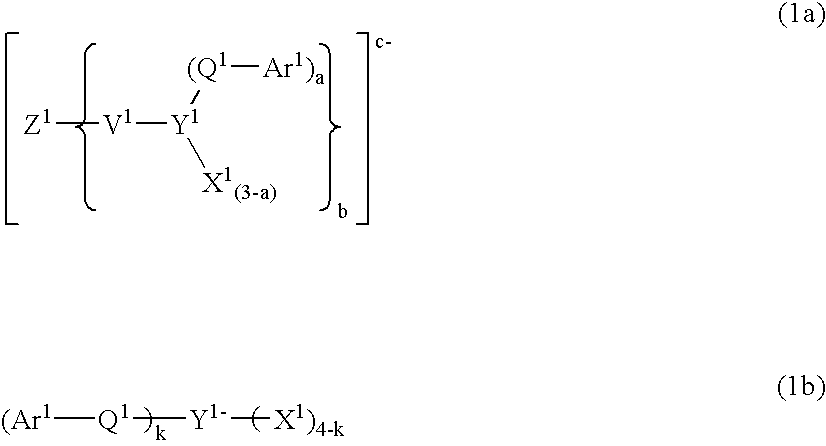Luminescent-polymer composition
a technology of light-emitting polymer and composition, which is applied in the direction of discharge tube luminescent screens, conductors, non-metal conductors, etc., can solve the problem that the device's life-time is not yet satisfactory
- Summary
- Abstract
- Description
- Claims
- Application Information
AI Technical Summary
Benefits of technology
Problems solved by technology
Method used
Image
Examples
synthetic example 1 (
SYNTHESIS OF COMPOUND A)
[0279] Inside of a 300 ml eggplant type flask was replaced by nitrogen, 5.00 g of tris(pentafluorophenyl)borane was dissolved in 200 ml dehydrated diethyl ether, and 0.31 g of potassium cyanide was added. After refluxing for 3 hours, the solvent was distilled off and 5.71 g of Compound A was obtained.
[0280] MS(ESI-negative)
[0281] m / z 1049.8([M-K]−)
K+|(C6F5)3B≡N—B(C6F5)3|− A
example 2 (
SYNTHESIS OF COMPOUND B)
[0282] Inside of a 25 ml Schlenk tube was replaced by nitrogen, 1,1′-dimethyl-4,43-bipyridinium dichloride 40 mg was dissolved in 4.0 ml water, and Compound A 400 mg was added. 4.0 ml of chloroform was added, and stirred for 4.5 hours. After being filtrated and washed, the solvent was distilled off, and 288 mg of Compound B was obtained.
[0283]1H-NMR (300 MHz, DMSO-d6)
[0284]δ 9.30 (4H, brs), 8.78 (4H, brs), 4.47 (6H, s)
example 3 (
SYNTHESIS OF COMPOUND C)
[0285] Inside of a 25 ml Schlenk tube was substituted by nitrogen, bis(4-t-butylphenyl)iodonium triflate 150 mg was suspended in 4 ml water. Compound A 392 mg was added, and further toluene 3 ml was added, then the insoluble material was dissolved. After 8 hours' stirring, being partitioned and the aqueous phase was extracted with toluene. After being dried by sodium sulfate, the solvent was distilled off, and 373 mg Compound C was obtained.
[0286]1H-NMR (DMSO-d6, 300 MHz)
[0287]δ 8.16 (4H, d), 7.55 (4H, m), 1.26 (18H, s)
[0288]19F-NMR (DMSO-d6, 300 MHz)
[0289]δ−132.5, −133.6, −134.1, −157.8, −159.7, −164.1, −165.2
PUM
| Property | Measurement | Unit |
|---|---|---|
| Temperature | aaaaa | aaaaa |
| Percent by mass | aaaaa | aaaaa |
| Percent by mass | aaaaa | aaaaa |
Abstract
Description
Claims
Application Information
 Login to View More
Login to View More - R&D
- Intellectual Property
- Life Sciences
- Materials
- Tech Scout
- Unparalleled Data Quality
- Higher Quality Content
- 60% Fewer Hallucinations
Browse by: Latest US Patents, China's latest patents, Technical Efficacy Thesaurus, Application Domain, Technology Topic, Popular Technical Reports.
© 2025 PatSnap. All rights reserved.Legal|Privacy policy|Modern Slavery Act Transparency Statement|Sitemap|About US| Contact US: help@patsnap.com



